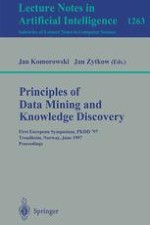1997 | Buch
Principles of Data Mining and Knowledge Discovery
First European Symposium, PKDD '97 Trondheim, Norway, June 24–27, 1997 Proceedings
herausgegeben von: Jan Komorowski, Jan Zytkow
Verlag: Springer Berlin Heidelberg
Buchreihe : Lecture Notes in Computer Science
Enthalten in: Professional Book Archive
